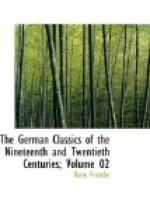“That the grammarians, painters and sculptors fared as did also the orators, every one will find who examines the testimony of the ages; the highest development of every art is invariably circumscribed by a very short space of time. Just why a number of similarly endowed, capable men make their appearance within a certain cycle of years and devote themselves to the same art and its advancement, is a matter upon which I have often reflected, without discovering any cause that I might present as true. Among the most probable causes the following seem to me the most important: Rivalry nourishes the talents; here envy, and there admiration, incite to imitation, and the art promoted with so much diligence quickly reaches its culmination. It is difficult to remain in a state of perfection, and what does not advance retrogrades. And so in the beginning we endeavor to attain our models, but when we despair of surpassing or even approaching them, diligence and hope grow old, and what we fail to attain, is no longer pursued. We cease to strive after the possession already obtained by another, and search for something new. Relinquishing that in which we cannot shine, we seek another goal for our efforts. From this inconstancy, it seems to me, arises the greatest obstacle to the production of perfect works of art.”
A passage of Quintilian, containing a concise outline of the history of ancient art, also deserves to be pointed out as an important document in this domain. In his conversations with Roman art lovers, Quintilian must also have noticed a striking resemblance between the character of Greek artists and Roman orators, and then have sought to gain more exact information from connoisseurs and art-lovers. In his comparative presentation, in which the character of the art is each time associated with that of the age, he is compelled, without knowing or wishing it, to present a history of art.
They say that the first celebrated painters whose works are visited not by reason of their antiquity alone, were Polygnotus and Aglaophon. Their simple color still finds eager admirers, who prefer such crude productions and the beginnings of an art just evolving, to the greatest masters of the following epoch—as it seems to me in accordance with a point of view peculiar to themselves. Afterward Zeuxis and Parrhasius, who lived at about the same period—at the time of the Peloponnesian war—greatly promoted art. The former is said to have discovered the laws of light and shadow, the latter to have devoted himself to a careful investigation of lines. Furthermore, Zeuxis gave more content to the limbs and painted them fuller and more portly. In this regard, as is believed, he followed Homer, who delights in the most powerful forms, even in women. Parrhasius, however, has such a determinative influence that he is called the law-giver of painting, because the types of gods and heroes which he created were followed and adopted by others as norms.




